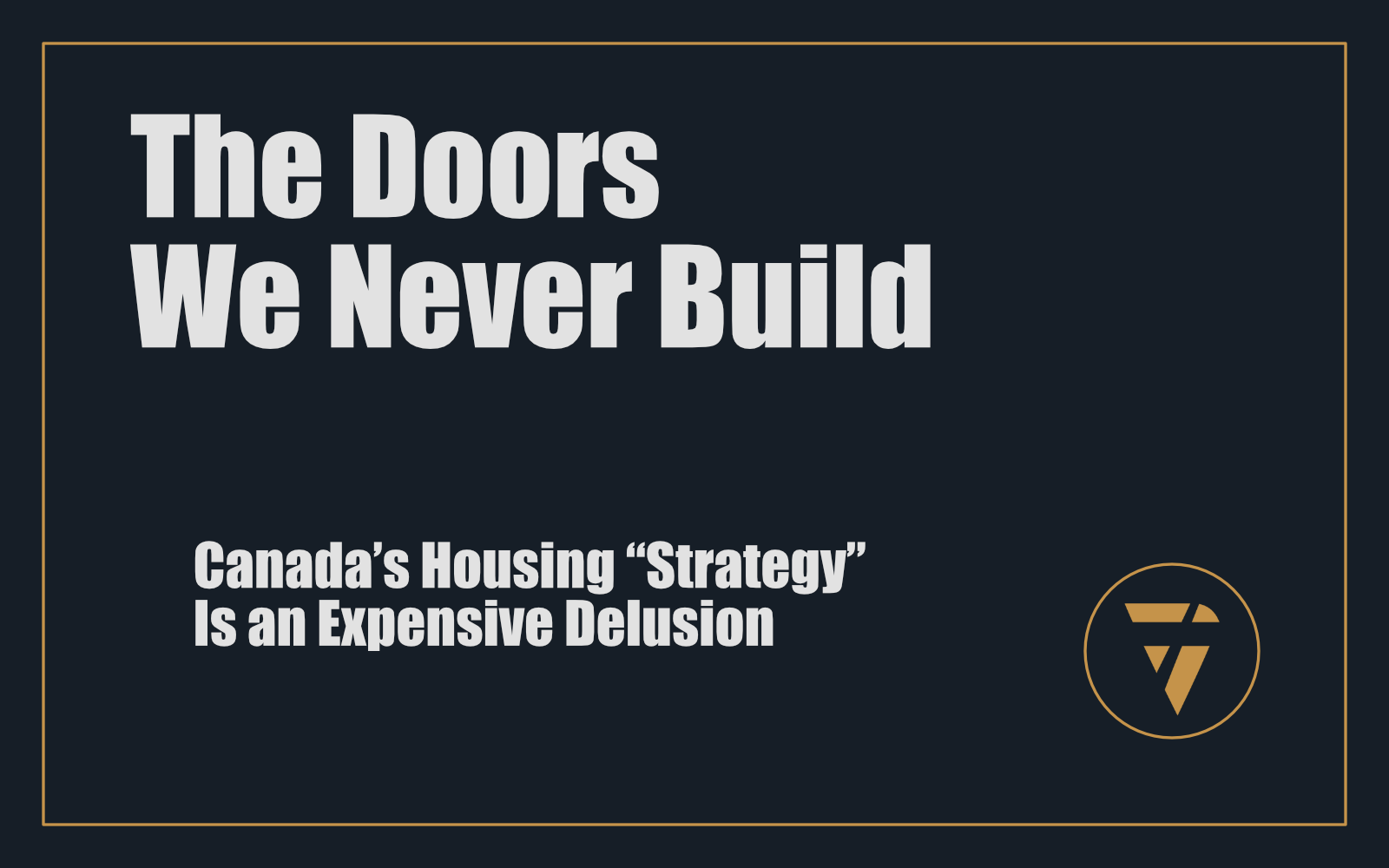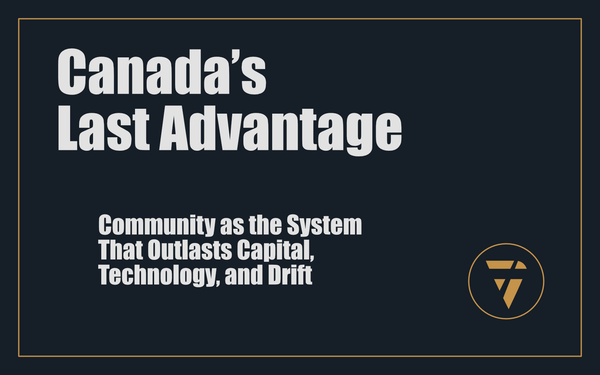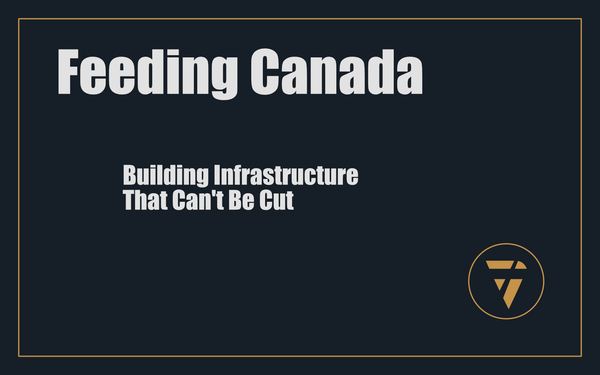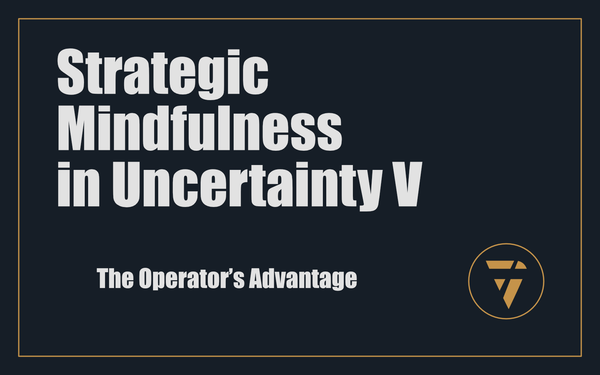The Doors We Never Build

Canada’s Housing “Strategy” Is an Expensive Delusion
The average Canadian doesn’t care about housing policy. They care about whether they can afford to live near their job, raise their kids in safety, and retire without fear. The average Canadian has already lost on all three fronts. The architects of that failure are easy to name: policy layers without operators, capital without criteria, and a construction industry still pretending this is 1998.
Let’s begin with the signal.
Canada is short by hundreds of thousands of homes—at least 320,000 nationally according to CMHC, and well over 40,000 in cities like Calgary and Saskatoon alone when priced-out buyers and invisible renters are included. These are not speculative numbers. These are the humans forced into extended leases, decade-long waits for “affordable” units, or relocations out of the market altogether. The crisis is no longer hypothetical. It is structural, visible, and escalating.
But here’s the deeper truth: the gap isn’t just in quantity. It’s in fitness. The homes that exist do not meet the energy, location, or price thresholds of the people who actually need them. What’s on offer is either too expensive, too inefficient, or too far from where people live and work.
That’s not a housing market. That’s a compliance machine.
HOW WE GOT HERE: POLICIES, PERMITS, AND PROFITEERS
The failure isn’t in the rhetoric. It’s in the result. Canada has poured billions into housing strategies that yield reports, grants, and headlines—but almost no homes. Why? Because almost every “solution” is rooted in profit logic, not operational reality.
Municipalities are choked by permit timelines and discretionary approvals that can stretch to 24 months or more. Developers are forced to fund carry costs for land they can’t even break ground on. Builders, meanwhile, operate in a system optimised for volume over integrity, speed over performance, and cost over consequence.
And the crown jewel of this dysfunction? The CMHC-backed affordability models that assume a 30-year amortization, fixed utility costs, and no climate risk. These models are fiction. In reality, young families are committing to $3,000+ monthly cash flow burdens for homes that leak heat, bleed value, and require $100,000 in upgrades just to survive a Prairie winter.
It’s not just unaffordable. It’s unliveable.
THE CONSTRUCTION CARTEL
Now look deeper. Ask any developer what happens when they try to build high-efficiency homes at entry-level prices. You’ll hear the same refrain: “Can’t be done.” Why? Because the industry isn’t optimised to deliver outcomes. It’s optimised to preserve supply chains, protect margin layers, and stretch project timelines to match capital cycles.
Contractors are rewarded for activity, not completion. Trades are booked six months in advance for work they haven’t seen. And energy performance? That’s someone else’s department. The result: homes that cost more every year to operate, require emergency retrofits within a decade, and trap owners in rising cost curves they didn’t sign up for.
Ask why we don’t have Passive House as standard, and they’ll say the market won’t pay for it. That’s a lie. The market isn’t even offered it.
WHAT BUYERS ACTUALLY WANT
The real Canadian buyer isn’t looking for granite countertops and open-concept. They’re looking for predictability. A fixed-price home. Guaranteed delivery. Low utility bills. Indoor air that doesn’t make their kids sick. A place they can live, safely, without being one interest rate decision away from financial collapse.
We ran the numbers.
Start with a base model 900 sq ft Passive House certified, 2-bedroom, 2-bath home in Saskatoon. Offer it on titled land, with lender pre-approval, transparent contracts, and staged deposits. Deliver it in six months. You’ll have more buyers than homes. Not speculative investors. Not foreign buyers. Actual families.
Now try getting that built through conventional channels. You won’t. Because nothing about our current system is built to support this kind of delivery. Municipal approvals won’t allow for template-based design and fast-track permitting. Builders don’t train for airtightness or panelised installs. Banks don’t fund construction on contract-backed presales unless they’re dealing with legacy developers who still build energy sieves.
So even if you know what the market wants, the system is designed to stop you from delivering it.
THE OPERATOR MODEL
Here’s what we did instead.
We created a pre-sale platform. Buyers choose a model, reserve a lot, and lock a fixed price. Deposits are staged to match milestones. Permits are submitted on pre-approved plans. Construction is broken into seven gates, each with QA signoff. Every build is Passive House–certified, with airtightness tested and energy savings modelled against utility bills.
From reservation to keys? 26 weeks.
Capital cycle? Under 9 months.
Price volatility? Zero.
Buyers? Lined up.
This isn’t hypothetical. The first 10-unit pilot is live in Langham, SK. The 100-home template is sequenced next. Then comes the 1,000-home pipeline in Saskatoon and surrounding municipalities. Not concept. Not press release. Built.
WHY THIS MODEL WINS
This model doesn’t care about what the industry says is possible. It only cares about compression. Compress the build time. Compress the energy bill. Compress the buyer’s risk. And compress the capital exposure required to build homes that actually meet market demand.
That’s how you beat the developers: deliver better, cheaper, faster.
That’s how you beat the lenders: show them a qualified, cash-backed backlog.
That’s how you beat the regulators: bypass the red tape with standardised, pre-approved builds.
And that’s how you beat the crisis: by actually building what people need.
WHAT COMES NEXT
If you’re a policymaker reading this, stop funding reports and start issuing permits.
If you’re an investor, stop chasing multi-family REITs and start underwriting actual homes.
If you’re a buyer, stop waiting for a crash that won’t come. The system isn’t broken. It was built this way.
We’re not trying to reform housing.
We’re replacing it.
This is what I’m working on. Tell me what you think, I enjoy the conversation! Subscribe and follow the work in real time.
Thanks!
B

Here’s your BlueSky post — built for consequence, stripped of filler, and engineered to move capital, signal truth, and provoke the right questions:
Canada’s housing “strategy” is an expensive delusion.
We don’t need another report. We need homes. Fast, fixed-price, climate-secure homes that real people can own.
The problem isn’t money. It’s motion.
No more waiting.
PS -






